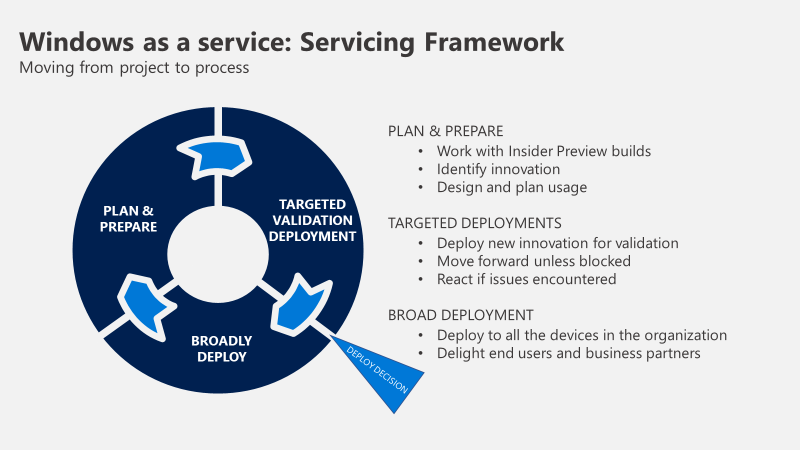Moving from Project to Process
[For English readers, a translation of this article can be found at the end of the page]
Diverse aziende stanno introducendo Windows 10 al loro interno ma solo alcune si preccupano di abbracciare il modello As a Service che permette di portare innovazione continua sia per quanto riguarda le tematiche di produttività che di sicurezza che di gestione.
Windows 10 è strettamente derivato da Windows 7 e 8 per cui le problematiche relative a compatibilità applicativa sono minori rispetto al passaggio tra XP e Windows 7. La vera sfida è quella di implementare un processo di Change Management all'interno della propria azienda in grado di supportare l'introduzione continua di novità all'interno della piattaforma Windows 10.
E' necessario che la struttura IT sia in grado di aggiornare in modo continuo le postazioni di lavoro abilitando nuove funzionalità man mano che queste vengono rese disponibili tramite nuove versioni di sistema operativo.
Dall'altra parte è altrettanto importante che si abbia un canale di comunicazione con gli utenti finali necessario per informarli della disponibilità di nuove funzionalità che possono andare a cambiare in meglio il modo in cui lavorano.
Un articolo di interesse relativo a questi ambiti è quello scritto dal mio collega John Wilcox a proposito del cambio di mentalità tra progetto di implementazione e processo di aggiornamento continuo. LINK
Several companies are introducing Windows 10 but only few of them are embracing the new As a Service model introduced by this new operating system. This new model allows to bring continuos innovation on the productivity, security and management side.
Windows 10 is strictly derived from Windows 7 and 8 so the problems related to application compatibility are not a key aspect in the migration like in the past where lot of companies struggled in the transition between XP and Windows 7. The real challenge in Windows 10 adoption is in implementing a Change Management process within your company to be able to support the continuous introduction of new features.
It is necessary that the IT group will be able to continuously update the workstations by enabling new functionalities as they are made available through new versions of the operating system.
On the other side, it is equally important to have a communication channel with the end users necessary to inform them of the availability of new features that can change the way they work bringing more productivity.
An useful article related to these topics is the one written by my colleague John Wilcox about the change in mentality between implementation project and continuous updating process. LINK
